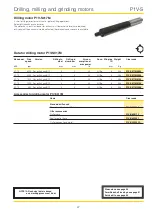
58
Stainless Steel Air Motors
P1V-S
Frictional Forces between two Objects
A frictional force always occurs between two objects with
surfaces in contact with each other. It is always exerted against
the direction of movement.
The frictional force is either static or kinetic. When selecting
an air motor, we need to consider the larger of the two forces,
static or kinetic.
The size of the static frictional force or the kinetic frictional
force is the product of the normal force F
n
and the coefficient of
static friction (µ
0
), or the product of the normal force F
n
and the
coefficient of kinetic friction (µ).
The size of the contact surface between the objects is irrel-
evant.
Formula:
F
static
= F
n
x µ
0
F
kinetic
= F
n
x µ
F
n
= m x g
F
static
= static friction in N
F
kinetic
= kinetic friction in N
F
n
= force from object in N
m = mass in kg
g = gravitation (9,81) in m/s
Material
Coefficient of static friction µ
0
Dry
Lubricated
Bronze
Bronze
0,8
0,11
Bronze
Grey iron
0,8
0,16
Grey iron
Grey iron
-
0,16
Steel
Bronze
0,7
0,11
Steel
Ice
0,07
-
Steel
Grey iron
0,0
0,10
Steel
Steel
0,15
0,10
Steel
White metal
-
-
Wood
Ice
-
-
Wood
Wood
0,65
0,16
Leather
Grey iron
0,55
0,
Brake lining
Steel
-
-
Steel
Nylon (polyamide)
-
-
Material
Coefficient of kinetic friction µ
Dry
Lubricated
Bronze
Bronze
0,
0,06
Bronze
Grey iron
0,1
0,08
Grey iron
Grey iron
-
0,1
Steel
Bronze
0,18
0,07
Steel
Ice
0,014
-
Steel
Grey iron
0,16
0,05
Steel
Steel
0,10
0,05
Steel
White metal
0,0
0,04
Wood
Ice
0,035
-
Wood
Wood
0,35
0,05
Leather
Grey iron
0,8
0,1
Brake lining
Steel
0,55
0,40
Steel
Nylon (polyamide)
0,5
0,10
Example: A steel component with a weight of 500 kg is to be
pulled across bronze plate without lubrication. What will the
frictional force be when the component moves?
F
static
= F
n
x µ
0
F
kinetic
= F
n
x µ
F
static
= 500 x 9,81 x 0,7 = 134 N
F
kinetic
= 500 x 9,81 x 0,18 = 883 N
The static frictional force should always be compared with the
force provided by the motor when it starts.
Kinetic Resistance
Kinetic resistance is a term expressing the total resistance,
consisting of rolling resistance and the frictional force in the
bearing
Formula:
F
F
= µ
F
x F
n
F
F
= kinetic resistance in N
µ
F
= coefficient of kinetic resistance
F
n = force from object in N
Coefficient of kinetic resistance:
Object
Coefficient of kinetic
resistance
Railway vehicle on steel rails
0,0015 to 0,0030
Vehicle with rubber wheel on asphalt
0,015 to 0,03
Example:
A railway carriage with a weight of tonnes is to move over flat
rails. What will the kinetic resistance be?
F
F
= µ
F
x F
n
F
F
= 0,0030 x x 1000 x 9,81
F
F
= 4,86 N
F
n
F
F
F
static
F
kinetic
F
n
F
friction
Summary of Contents for 1P1V-S020A00005
Page 66: ...66 Stainless Steel Air Motors P1V S...
Page 67: ......











































